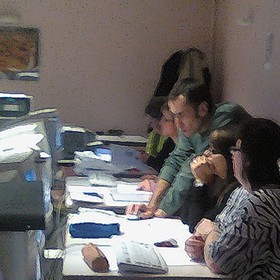 Image via WikipediaIn some recent postings on connectivism and constructivism (see links below), educators and researchers write as if these models are oppositions; as if constructivism is early Bolshevist and connectivism is free market socialism. Pedagogy does not come from research and theorizing but from practice. The learning landscape changes over time and as the technology changes, we need new models to describe how people are learning. Connectivism is the next step in understanding how people learn in the digital age. Behaviorist and constructivist pedagogies describe a certain kind of learning that takes place in a particular milieu. Networks have changed a lot about the learning landscape, but on the other hand, much of how humans communicate and engage with one another has not. It happens faster, more often and over a wider population. I am talking to educators in India, China, and South America. I would not be talking to as many people around the world without the internet. There is a synergistic aspect to networks - we are smarter together than we are individually. There are network behaviors that are very different than purely social behaviors. Constructivist teaching is also occurring in networks. Connectivist learning is also happening. Will constructivist teaching fade away like feudal economies of old Europe?
Image via WikipediaIn some recent postings on connectivism and constructivism (see links below), educators and researchers write as if these models are oppositions; as if constructivism is early Bolshevist and connectivism is free market socialism. Pedagogy does not come from research and theorizing but from practice. The learning landscape changes over time and as the technology changes, we need new models to describe how people are learning. Connectivism is the next step in understanding how people learn in the digital age. Behaviorist and constructivist pedagogies describe a certain kind of learning that takes place in a particular milieu. Networks have changed a lot about the learning landscape, but on the other hand, much of how humans communicate and engage with one another has not. It happens faster, more often and over a wider population. I am talking to educators in India, China, and South America. I would not be talking to as many people around the world without the internet. There is a synergistic aspect to networks - we are smarter together than we are individually. There are network behaviors that are very different than purely social behaviors. Constructivist teaching is also occurring in networks. Connectivist learning is also happening. Will constructivist teaching fade away like feudal economies of old Europe?An important point that should be made is that the social dimension of learning in constructivism isn't negated by connectivism. There is much that is complementary. To over-simplify, Connectivism accounts for the networks and learning in networks; constructivism accounts for what happens in them. Networks are only a means. Communication, interaction, and engagement all have to take place before anyone learns anything. Information itself is not knowledge. Forming a connection does not mean that any kind of engagement must or will take place.
In some of the online classes I have experienced with George Siemens (which I highly recommend), I see much of the constructivist pedagogies at work:
All of the conversations about tools and personal learning networks presuppose an individual with some technical skills, facility with managing information and networks, the critical thinking skills to interpret that information, and a fairly high degree of motivation. All of these seem to be taken for granted - in the community college system (at least here in Humboldt Co.) and in less developed countries, one cannot make the assumption that networks in themselves will lead to learning. I am going to have to use all of the techniques of constructivist learning to show the value and purpose of these networks. I need to bring in the students prior knowledge and experience and guide them in applying that to new information and skills.








